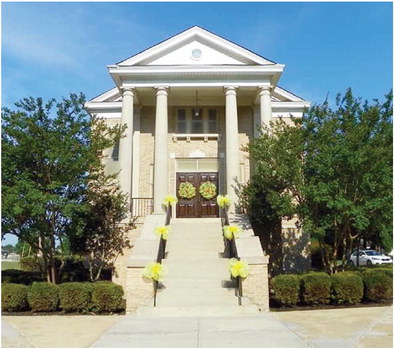A celebration 110 years in the making

A celebration 110 years in the making
FUMC has changed over the ( many) years
news@theeveningtimes.com
One hundred and ten years ago on a cold morning on Jan. 6, 1906, 13 people met in Earle to form a Sunday school and to listen to a circuit riding preacher by the name of Bedford Harris.
The group of worshipers formed First United Methodist Church which recently celebrated its 110th Sunday service with a special communitywide Heritage Sunday event June 12.
The event drew about 130 people, many of which returned to Earle to reconnect with family and friends and to see the place they grew up worshiping in.
“They just had the best time getting to see people,” said Jane Speed, who has been attending the church since 1957. “A lot of them were in the 35 to 55 age group which was nice.”
According to church history, prior to 1906, local Methodists attended Gibson Bayou Church.
Their church’s founders met in a small building at 1232 Second Street in Earle to form a Sunday school and church. The mixture of Methodists and Baptists rotated pastors every two weeks.
Rev. Bedford Lee Harris, who was named after Confederate Generals Nathan Bedford Forrest and Robert E. Lee, had recently been transferred from the Methodist Conference to the White River Conference of Arkansas and was appointed to the Marion-Crawfordsville Circuit, which included all of Crittenden County.
In the early days he traveled by foot, train, horse and buggy to serve his parishioners.
While in Earle, Harris organized and built the Earle Methodist Episcopal Church South, and later he went to Wynne and Newport where he built new churches in both cities. In 1906-07 he served both the Earle and Crawfordsville churches.
In 1933, the parsonage at 1120 Fourth Street burned and the church records were lost.
But according to a reconstructed list, the founding members in 1906 were Effie Aston, Charles Grigsby Barton, Susie Foster Barton, Laura Boone, Pearl Donahoe, R.C. Donahoe, Georgia Fullwood, James Fullwood, Lewis Machen, Laura Machen, Mrs. L.E.
Marshall, Frank Morehead, Minnie Morehead, Ella Nance, Mable Owen, Etta Roeder, and Adolphus ‘Bob’ White.
Church membership grew to about 325 in 1952.
A new $40,000 building was constructed in 1929, but along with the stock market crash and the Great Depression, the $20,000 mortgage caused financial hardship. But with the help of its faithful members, the bonds were refinanced in 1934 and paid off ahead of schedule in 1943.
On a lighter note, church history recounts that wasps were frequent visitors during Sunday service. One member of the choir, Euletta Hood, stopped attending after the wasps got too aggressive.
On another occasion, usher R.A. Scott was passing the plate one morning and when very few coins were collected, he gently raised one of the stained glass windows, dumped the contents of the plate out the window, then took money from is own pocket in the plate for the offering.
And once, a young son of a pastor who had just arrived in Earle excitedly told his grandfather that “we live across the street from a castle.” The home he was referring to was the W.P. Morrison residence.
Other notable milestones in the church’s history include Becky Knapp who in June 2001 was recognized for 55 years of perfect attendance at the Sunday school.
Also, the Messenger, the church monthly newsletter which began in 1976, is still going strong.
Speed said like a lot of churches today, they are seeing their membership dwindle.
The church has about 50 people on the books but about 30 who are active and attend worship each week.
But the ones who are still active are very sentimental and devoted to it.
“I think every one of us is attached to the place,” Speed said. “Our kids grew up here.”
Speed’s husband was the long-time choir director and she said the church always had wonderful music. Mamie Watson, whose husband was Dr.
Watson, played the organ and lived to be over 100 years old.
“My husband studied at Shenandoah Music Conservatory in Virginia,” Speed said. “He was very talented. We just always had beautiful music through the years.”
Speed said one of the reasons she believes the church has survived is because it has always had a strong commitment to the community.
“We’re down to so few.
But we still serve the community,”
Speed said. “Last
year we had 30 kids in Sunday school. They were mostly minority kids from the neighborhood. And we have people come back occasionally like my two sons from Little Rock, and other people who support it financially.”




By Mark Randall


Share